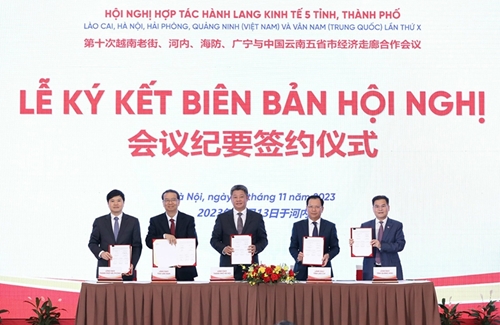Dr. Le Xuan Sang, Deputy Director of the Vietnam Institute of Economics under the Vietnam Academy of Social Sciences, granted an exclusive interview for reporters of the People’s Army Newspaper to clarify this cooperation orientation.
In the joint statement, the two sides agreed to foster deeper and more practical cooperation in different fields. Dr. Le Xuan Sang said that this orientation will generate many opportunities for the cooperation between the two countries in the future. In investment, the statement says that “the two sides encourage and support businesses with real capacity, prestige, and advanced technologies to invest in the other country.” This new point will further facilitate Vietnamese businesses to invest in China.
    |
 |
|
The 10th conference on economic corridor cooperation among five provinces and cities of Hanoi, Hai Phong, Quang Ninh and Lao Cai of Vietnam and China’s Yunnan province was held in Hanoi on November 13, 2023. (Photo provided by the organizing panel) |
On the other hand, encouraging and supporting Chinese enterprises with real capacity, prestige, and advanced technologies to invest in Vietnam, especially public investment in important national infrastructure projects will help reduce negative effects on Vietnam’s economy, thus building a better image to Chinese businesses.
Another positive orientation is “promoting the implementation of projects using non-refundable aid funded by the Chinese Government for Vietnam, including a project to build the second facility of the Traditional Medicine Hospital.” Mr. Sang emphasized that it will help both enhance the capability of treating patients using traditional medicines and avoid excessive public debt. He added that Vietnam should pay attention to considering attached conditions and requirements.
Another important content is that the two sides actively seek the possibility of strengthening bilateral and multilateral cooperation in the field of key minerals. He said that Vietnam should carefully consider fields, levels of participation, benefits, and commitment to ensure the effectiveness and energy security and position of the country.
In the field of finance, currency, the two sides agreed to increase the exchange and cooperation between the two countries’ financial supervisory and management agencies. Mr. Sang evaluated that this is a great effort in raising the effectiveness of monetary policies, efficiency in the fields of debt and foreign trade, and ensure financial security.
In addition, Vietnam has an advantage of food industry, while China has strengths and pioneers in green technology development. These advantages help the two countries enhance their ability to support each other for mutual benefit and in accordance with common interests.
Since the two peoples have similar culinary tastes, and China is credited as an easy-to-please market, the implementation of the Regional Comprehensive Economic Partnership (RCEP) and digitization of customs procedures will help the two countries’ trade policies become more transparent and convenient.
Mr. Sang said that Vietnam has become attractive to Chinese investors thanks to its signed free trade agreements. In addition, the Vietnamese market is large and stable enough for China to invest effectively and reduce investment and trade risks. He added that to attract investment from China, it is necessary to well control environmental standards and transaction conditions in merger, consolidation, and acquisition projects, especially strategic projects.
A new content in this joint statement is the two sides’ agreement on jointly building “Two Corridors, One Belt,” and “Belt and Road.” Dr. Le Xuan Sang evaluated that this is a positive direction, creating commercial advantages and promoting trade, investment, and tourism between the two countries, especially enhancing the effectiveness in improving the quality of infrastructure and logistics. The Deputy Director of the Vietnam Institute of Economics stressed that promoting connectivity will help Vietnam have railways meeting international standards, thus enhancing the efficiency of transport. However, Vietnam should make careful assessment, build strategic policies, and determine the size of human resources, material resources, and capitals based on careful calculation of benefits and cost in medium- and long-term periods.
To achieve the target of expanding the size of bilateral trade in a balanced and sustainable direction, the Deputy Director of the Vietnam Institute of Economics noted that if measures determined in the joint statement, including applying effective measures to ensure smooth commodity supply chains serving the production and consumption between the two countries and in the region, are effectively implemented, they will bring benefits for both countries. In the document, the two sides issued specific measures to promote trade and cooperation, allowing the two countries' goods to penetrate deeper into each other's markets. Recently, the Chinese side announced that it will actively accelerate the market opening process for Vietnamese exports through official channel, contributing to raising values, stabilizing turnover, and reducing Vietnam's trade deficit.
Mentioning the situation of goods congestion at border gates which partly stems from the asynchronous and ineffective coordination between the two sides, Mr. Sang emphasized that improving customs clearance efficiency, promoting the pilot building of smart border gates is another important and practical direction. This commitment helps both sides check or notify in advance to help businesses far from the border have complete and timely information about goods, thereby reducing risks related to exporting goods, especially agricultural products.
Reporters: Thank you very much!
(to be continued)
By Ngoc Hung – Van Duyen – Vu Hung
Translated by Tran Hoai